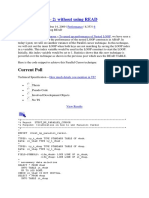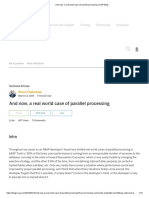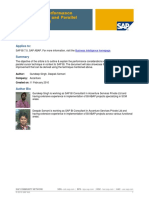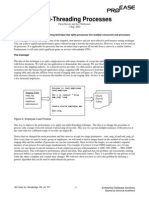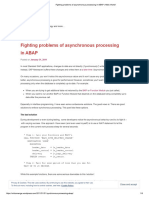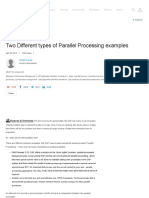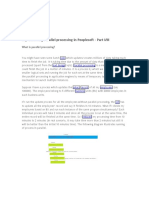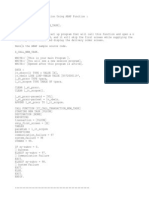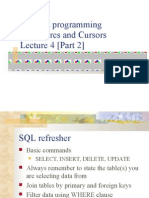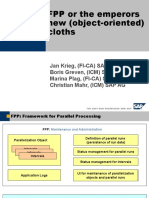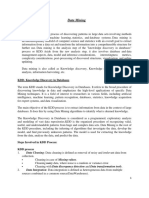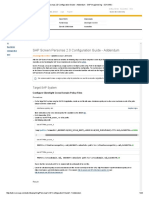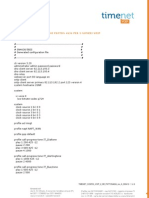Parallel Cursor and Parallel Processing in ABAP
This document explains the concepts of Parallel Cursor and Parallel Processing in ABAP with examples.
1. Parallel Cursor
🔹 Concept
The parallel cursor technique is used to improve performance when looping through two internal tables
with a relationship (like parent-child). Instead of nested loops (which are costly in performance), you move
pointers (cursors) in parallel.
🔹 Example: Fetching Sales Orders and Items
Without Parallel Cursor (Nested Loop):
LOOP AT lt_vbak INTO ls_vbak. " Header Table
LOOP AT lt_vbap INTO ls_vbap " Item Table
WHERE vbeln = ls_vbak-vbeln.
WRITE: / ls_vbak-vbeln, ls_vbap-posnr.
ENDLOOP.
ENDLOOP.
⚠️ Performance issue: If lt_vbak has 10,000 rows and lt_vbap has 50,000 rows, nested loops are expensive.
With Parallel Cursor:
SORT lt_vbap BY vbeln.
LOOP AT lt_vbak INTO ls_vbak. " Header Table
READ TABLE lt_vbap INTO ls_vbap WITH KEY vbeln = ls_vbak-vbeln
BINARY SEARCH.
IF sy-subrc = 0.
lv_index = sy-tabix.
LOOP AT lt_vbap INTO ls_vbap FROM lv_index.
IF ls_vbap-vbeln <> ls_vbak-vbeln.
EXIT.
ENDIF.
WRITE: / ls_vbak-vbeln, ls_vbap-posnr.
1
� ENDLOOP.
ENDIF.
ENDLOOP.
✅ Much faster because item table is scanned only once per header instead of repeatedly.
2. Parallel Processing
🔹 Concept
Parallel processing in ABAP distributes workload across multiple work processes to speed up execution.
This is useful for long-running jobs like mass data updates.
It is achieved using Asynchronous RFC (aRFC).
🔹 Steps for Parallel Processing
1. Split data into packages (chunks).
2. Call a function module in parallel tasks ( CALL FUNCTION ... STARTING NEW TASK ).
3. Collect results using callback routine.
🔹 Example: Parallel Processing with aRFC
DATA: lt_data TYPE TABLE OF mara,
lt_sub TYPE TABLE OF mara,
lv_lines TYPE i,
lv_pack TYPE i VALUE 1000,
lv_from TYPE i VALUE 1,
lv_to TYPE i.
SELECT * FROM mara INTO TABLE lt_data.
lv_lines = lines( lt_data ).
WHILE lv_from <= lv_lines.
lv_to = lv_from + lv_pack - 1.
APPEND LINES OF lt_data FROM lv_from TO lv_to TO lt_sub.
CALL FUNCTION 'Z_PROCESS_DATA' STARTING NEW TASK lv_from
PERFORMING callback_form ON END OF TASK
EXPORTING it_data = lt_sub.
2
� CLEAR lt_sub.
lv_from = lv_to + 1.
ENDWHILE.
WAIT UNTIL gv_tasks = 0.
FORM callback_form USING taskname.
gv_tasks = gv_tasks - 1.
ENDFORM.
🔹 Function Module Z_PROCESS_DATA
This function module should be RFC-enabled.
FUNCTION z_process_data.
TABLES it_data STRUCTURE mara.
LOOP AT it_data INTO DATA(ls_data).
" Processing logic for each row
ENDLOOP.
ENDFUNCTION.
✅ This way, processing is distributed among multiple tasks instead of one sequential loop.
🔑 Key Differences
Concept Usage Benefit
Optimizes nested loops within a single Improves performance in joins/
Parallel Cursor
internal table processing parent-child relationships
Parallel Executes processing in multiple dialog/ Reduces runtime for large data
Processing background work processes volumes
📌 Summary
• Use Parallel Cursor for optimizing nested loops.
• Use Parallel Processing (aRFC) for splitting and processing large data sets across multiple work
processes.
• Both techniques are performance boosters but used in different scenarios.









